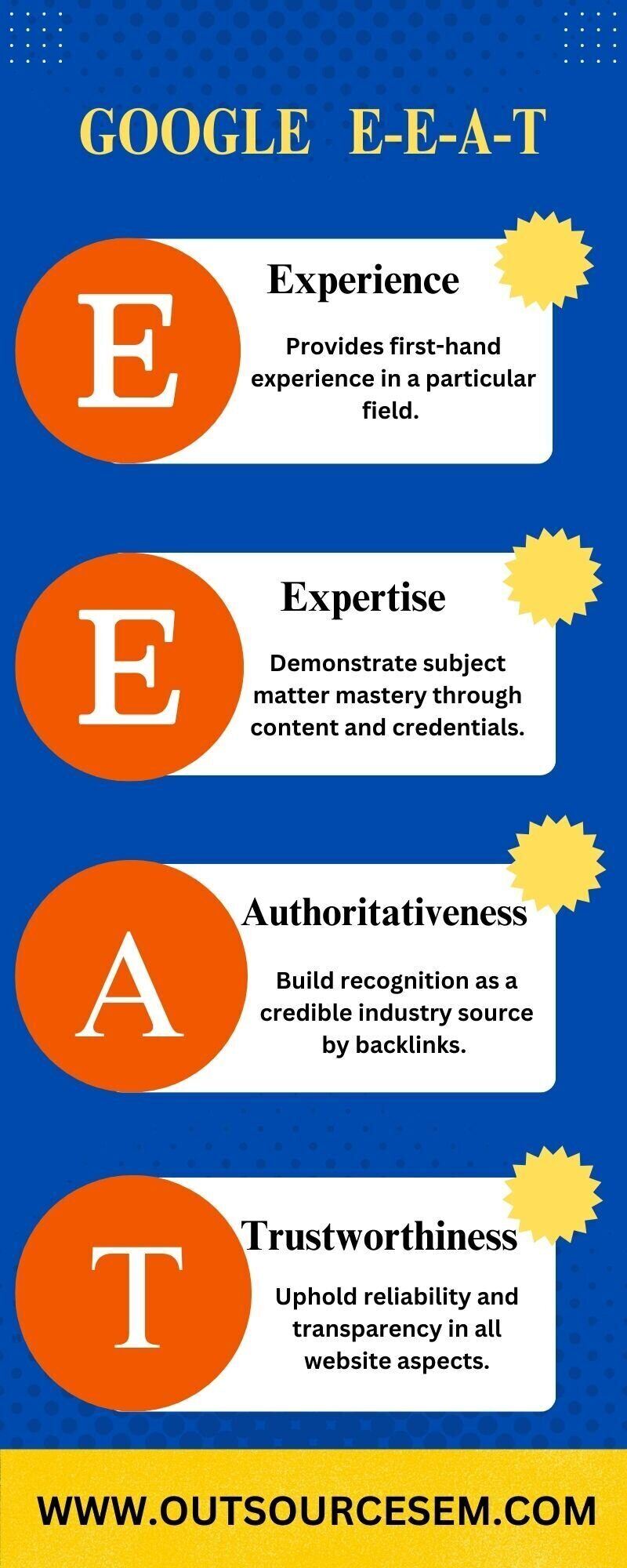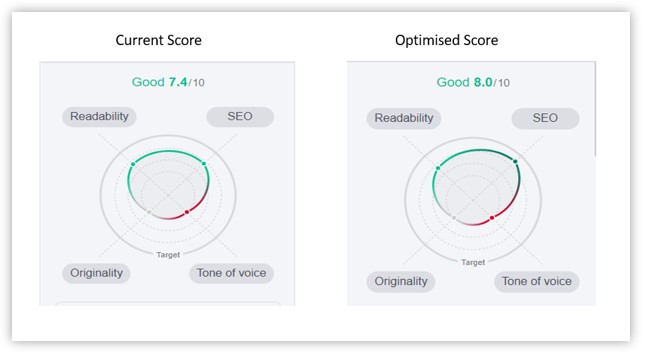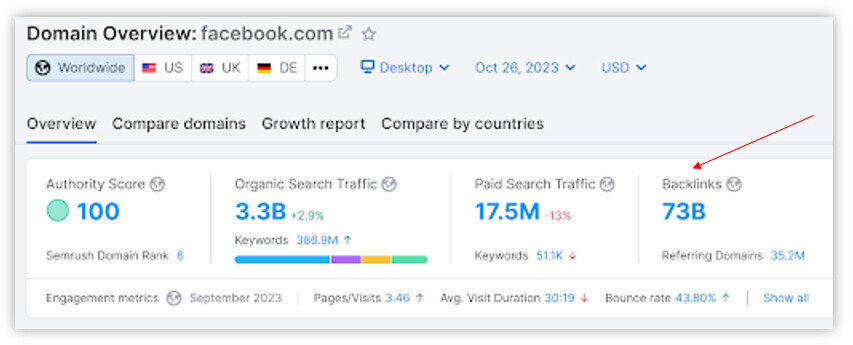Digital marketers and website owners must stay updated with Google's ranking algorithms in the ever-evolving world of search engine optimization (SEO). One of the most significant changes in Google Search Quality Rater has been transitioning from the well-known E-A-T (Expertise, Authoritativeness, and Trustworthiness) to E-E-A-T (Experience, Expertise, Authority, and Trustworthiness). This update reflects Google's dedication to providing users with reliable and high-quality information. To know more about Google E-A-T, you can read our blog on Google E-A-T and how it influences SEO. In this blog article, we will discuss what E-E-A-T stands for, why it's important, and how to optimize the website to increase website traffic, increase conversion rate, etc.
As online marketers, staying up-to-date with the latest digital marketing trends and following Google's updates is essential. For instance, responsive search ads have become the default type for expanded text ads, Google’s updates on broad matches, Google Algorithmic updates, and many others. One of the most crucial updates is the upgrade of Google E-A-T to Google E-E-A-T. Let us discuss the essential updates on Google E-E-A-T, tips to improve user experience, and more.
Understanding the acronym: Google E-E-A-T

Experience
Experience is a new addition to the E-E-A-T framework, emphasizing the importance of offering first-hand experience in a particular field and a good user experience on your website. How effectively your website meets the wants and expectations of its users is now taken into account by Google. Website speed, mobile friendliness, navigational simplicity, and graphical user interface are all elements that improve the user experience.
Given that an increasing number of people use the internet through smartphones and tablets, it is crucial to optimize your website for these devices. Your site will run smoothly on different screen sizes thanks to a responsive design, which will increase user satisfaction. As consumers prefer to leave websites that take too long to load, decreasing bounce rates requires improving page load times.
Tips to improve user experience
1. Optimize your website for mobile devices:
In the world of new media, mobile optimization is essential. Making sure your website is mobile-friendly is critical to the growing number of consumers who access websites via smartphones and tablets. When assessing E-E-A-T, Google places a lot of focus on mobile responsiveness. This implies that your website should automatically adjust to different screen sizes and resolutions. Consider using a responsive web design to accomplish this goal, automatically modifying the layout and information to match the user’s device. Since Google gives priority to mobile-friendly websites, mobile optimization can improve search ranks in addition to improving user experience.
As in PPC advertising, you focus on optimizing your ads for mobile devices so that your ads appear to the relevant target audience at the right time. In the same way, you can optimize your website for mobile devices so that users can easily access the website for keywords or search queries. You must also ensure that you have a good page loading speed so that the users do not leave your website and the bounce rate does not increase. As you outsource PPC services or avail of white label PPC services to improve the performance of PPC campaigns, perform PPC keyword research, conduct PPC audit, perform campaign analysis, etc. Similarly, you can avail of offshore digital marketing services so that SEO professionals can optimize your website for the best marketing goals.

2. Improve page load times to reduce bounce rates:
An essential component of the user experience is website ranking and speed. Users may become annoyed by pages that load slowly, which can result in high bounce rates and poor search engine results. Optimizing your website's loading times is the best way to solve this problem. In order to distribute content more effectively, this may entail image compression, making use of browser caching, and utilizing content delivery networks (CDNs). The Google Page Speed Insights tool may be used to pinpoint particular problems that require fixing. A website that loads quickly keeps visitors interested and adheres to Google’s demand for a good user experience.
For the PPC ad campaign, as you focus on the point of writing engaging headlines, attractive ad copies, ad descriptions, etc., so that the impression share of your PPC ads increases and the relevant users click on your ads. You can also add negative keywords to your ad campaign, which helps increase the ROI of your advertising budget , and the chances of your ad budget getting drained on irrelevant clicks are reduced. Whether you focus on location targeting, demographic targeting, etc., the crucial point is ensuring that you optimize your ad for mobile devices. Similarly, it would help if you focused on improving the page loading speed for your website so that the users navigate through different sections on the website and take the desired action.
3. Use clear and intuitive navigation menus:
E-E-A-T’s user-friendly navigation is another essential element. Visitors may quickly discover the information they need due to a well-organized, user-friendly navigation menu. In turn, this lowers bounce rates and keeps people on your website for longer. Think about classifying your content logically and giving your menu items titles that are informative and clear. A user-friendly navigation system can help with SEO, making it easier for search engines to scan and index your website. For writing great content, you can get help from content specialists from an SEO agency. You can also avail of white label SEO services to improve website navigation, ensuring that the visitors’ time on the page increases. To do so, conducting an SEO audit and preparing an SEO report is essential. The SEO analytics data would highlight the performance of crucial SEO metrics, and fixing the SEO mistakes and taking the necessary steps would increase the chances of visitors getting converted to customers.
_0.jpg)
4. Ensure that your website design is visually appealing and easy to read:
First impression matters, and how visitors interpret the content on your website is often influenced by its design. User engagement and trust may be increased by using a visually appealing design that is consistent with your brand’s identity. Readability is also important. So, maintain a clean and organized layout, use legible fonts, and ensure the content is simple to read against the background colour. You must also focus on writing unique content that grabs the user's attention on the webpage. Pay close attention to how whitespace reduces clutter and enhances the look. Always keep in mind that a well-designed website not only draws visitors but also keeps them interested and returning for more.
Expertise
Expertise is highly valued in E-E-A-T, just like in its predecessor, E-A-T. Google continues to prioritise websites that demonstrate a high level of expertise in the subject matter. In essence, your content should be factual, well-researched, and an excellent source of information. It should be written by people who are not only knowledgeable about the topic area they’re covering but who are also regarded as experts in it. This entails presenting the credentials and qualifications of your authors in addition to demonstrating your expertise through your content.
It is almost not possible to exaggerate the value of expertise. Google believes that incompetent people are more likely to steer false information. By showcasing expertise in your writing, you not only guarantee that your audience is given accurate information, but you also help your website build reputation and trust, two factors that are crucial for SEO. Implementing simple, intuitive navigation menus makes it easier for consumers to find information, keeps them interested, and reduces bounce rates. Finally, a website design that is both visually appealing and easy to read engages visitors and makes surfing more pleasant.
1. Clearly state the qualifications and credentials of your authors:
Transparency is essential in the realm of Google E-E-A-T. Users shouldn’t be in the dark about the credentials and experience of those who created the information on your website when they visit. Make sure to prominently disclose the qualifications of your authors, whether you are offering financial advice, medical advice, or any other kind of information. E.g. Your readers should be able to tell whether you are a licensed physician or other qualified healthcare professional if the content deals with medical subjects. Displaying the credentials of qualified financial planners or subject-matter specialists is crucial for financial advice. By putting these credentials in plain sight, you may build your audience’s trust and reassure them that the information they are getting comes from reliable sources.
2. Regularly update and revise your content to reflect the latest developments in your industry:
Almost every industry is affected by the ongoing evolution of digital marketing. It’s critical to maintain your content’s relevance to have a good domain authority in the relevant sector. A website’s reputation in Google’s views can be harmed by outdated information, which can potentially deceive users. Your audience will always receive the most current, relevant information if you regularly update and revise your content. Additionally, it shows search engines that you are actively involved in producing worthwhile content and keeping up with changes in the market.
3. Cite authoritative sources to support your claims and arguments:
In the Google E-E-A-T era, supporting your arguments with credible references is more crucial than ever. Citing reliable sources shows your dedication to truth while also increasing your authority through connection. It demonstrates that your information is fact-based rather than solely subjective or hypothetical. Make it a practice to provide links to reliable sources in your content, especially when giving statistical data or other information that needs verification. This not only highlights your knowledge, but also your dedication to producing dependable and trustworthy articles.
Authoritativeness
The Google E-E-A-T framework’s cornerstone of authority remains in existence. Google looks for websites that are recognized as reliable sources within their respective industry or niches. Gaining power takes time and depends on a number of variables. The quality and relevancy of your content are crucial since they may help you stand out from competitors by offering distinctive insights and value.
Building connections with other reputable websites is a calculated approach. Obtaining backlinks from these websites can increase the ranking of your website by telling Google that other reliable sources endorse your content. By interacting with your audience on social media and business forums, you may further establish your brand’s authority and visibility. Interactions that are regular and sincere help you build a reputation as an expert and reliable source.
Tips for building authority:
1. Create high-quality, authoritative content that provides unique insights and value:
Consistently creating excellent content is one of the best ways to gain authority in your area. Along with being thoroughly researched and precise, your content should also include original viewpoints or insights that distinguish you from competitors. This may entail carrying out fresh research, disseminating case studies, or offering thorough analysis. Quality content not only pulls in and keeps readers but it also inspires others in your field of expertise to provide references and links to your work, enhancing your authority.

2. Build relationships with other authoritative websites and seek backlinks from them:
Backlinks, or connections pointing to your website from other websites, are considered a powerful authority indication by Google. The quality and relevancy of those links are more important than simply the number of connections. Develop connections with reputable websites in your expertise or sector. This may be done by having guest posts, working together on content, or just having meaningful interactions. The reliability and authority of your website are increased when reliable websites connect to your content. It’s critical to concentrate on acquiring these backlinks organically rather than via spammy websites or deceptive methods, as Google frowns upon such behavior. When performing backlink analysis, it helps to analyze whether you are getting quality backlinks from relevant websites or irrelevant ones.

3. Engage with your audience on social media and industry forums to establish your brand's presence and authority:
Social media platforms and forums dedicated to your sector provide excellent possibilities to interact with your audience and show off your knowledge. You may establish your brand’s credibility as an expert in your industry by actively participating in discussions, responding to inquiries, and offering insightful commentary. You can use social media to distribute your content to a larger audience and promote discussion. Genuine involvement over time establishes you as a go-to resource for knowledge and insight in your field while also assisting you in connecting with your target audience.

Trustworthiness
In the E-E-A-T framework, trustworthiness, which has always been essential to SEO, has much more significance. Google is committed to ensuring that consumers can believe the data they discover online. To become trustworthy, your website must avoid spamming strategies, frauds, and deceptive information.
Maintaining user confidence requires keeping your website free of viruses and safeguarding it with HTTPs. Users are reassured of your validity by your openness about your company, including contact information and privacy policies. Publishing correct, fact-checked information will help you establish a strong reputation as a reliable source. Monitoring user-generated content, comments, and reviews is also essential to prevent spam or dangerous content from undermining the credibility of your website.
Tips for increasing trustworthiness:
1. Keep your website free from malware and ensure it’s secure (use HTTPs):
The foundation of building trust with your audience is website security. Users want to be able to read and engage with websites without being concerned about viruses or security flaws. Visitors are reassured that your website is trustworthy by the implementation of strong security measures, such as the use of HTTPs to encrypt data transfer, routine malware scanning, and the enforcement of strong password requirements. Users’ trust in the safeguarding of their information may be further increased by displaying trust badges or security certificates on your website.
2. Be transparent about your business, including contact information and privacy policies:
A fundamental component of trustworthiness is transparency. Your company’s contact information, such as your physical location, phone number, and email address, should be made plain and simple to find. Your company may be made more approachable and trustworthy by including a “About Us” page that details your goals, timeline, and team members. Furthermore, it is crucial to have a thorough privacy policy that describes how user data is gathered, kept, and utilized, especially at a time when privacy concerns are on the rise. Your disclosure of data practices demonstrates your dedication to user privacy and trust.
3. Publish content that is fact-checked and accurate:
In the digital era, accuracy is essential. Publishing content that has been carefully fact-checked and confirmed increases audience confidence and positions your website as a trustworthy source of information. Cite reliable sources in detail and include references as necessary. Spreading false or unreliable information can harm your website's credibility and reputation; therefore, refrain from doing so. Regularly update your content to reflect your industry's most recent findings and advancements, further demonstrating your dedication to accuracy.
4. Monitor user-generated content, comments, and reviews to prevent spam or harmful content:
User-generated content, such as forum posts, comments, and reviews, may have a big impact on how people view your website. To make sure that user-generated content complies with your content policy and maintains a courteous, educational, and spam-free tone, establish moderation criteria and continuously monitor it. Remove spam, offensive language, and damaging content immediately. To show your dedication to building a secure and interesting online community, encourage healthy debate and reply to user comments and inquiries properly.
YMYL websites
It’s crucial to remember that following the E-E-A-T principles is even more important for YMYL (Your Money or Your Life) websites since they offer information that may have a substantial influence on users' safety, financial security, or health. Given the possible real-world repercussions of their content, Google gives YMYL sites more attention to make sure the information they provide is accurate, dependable, and trustworthy. For websites in this category to achieve and keep user trust as well as search engine credibility, they must place a higher priority on knowledge, authority, and trustworthiness.
Conclusion
The E-E-A-T structure, which stands for Experience, Expertise, Authoritativeness, and Trustworthiness, demonstrates Google’s dedication to providing users with trustworthy content. Adhering to these guidelines is crucial for website owners and digital marketers in the ever-evolving world of SEO. A fundamental element is demonstrating knowledge through accurate, thoroughly researched information and highlighting the credentials of contributors. It is equally important to optimize for mobile devices, speed up page loads, and provide clear navigation to improve user experience.
Credibility is increased through establishing authority via the creation of excellent, authoritative content and by cultivating connections with reliable sources. Finally, a website’s reputation is strengthened by preserving trustworthiness through protection against malware, transparency, assurance of content accuracy, and moderation of user-generated content. If you find following Google’s E-E-A-T guidelines a tough task to follow when optimizing the website, you can contact a digital marketing company. Offshore SEO services can help scale the website performance and help achieve the desired online marketing goals. You can avail of white label SEO services and hire SEO professionals to increase website visibility. The SEO consultants have expertise in enterprise SEO, video SEO, local SEO, SEO reseller services, SEO plan & strategy, detox and penalty removal, etc., to improve the performance of the SEO campaign. By hiring our online marketing professionals you can also avail various other services for your industries like painting SEO, plumbing SEO, construction SEO, flooring SEO, electrician SEO and much more. Through these services you can increase digital visibility for your business and thus its profitability in the long run.
References:
. What are E-E-A-T and YMYL in SEO & How to optimize for them
. Our latest update to the quality rater guidelines: E-A-T gets an extra E for Experience
